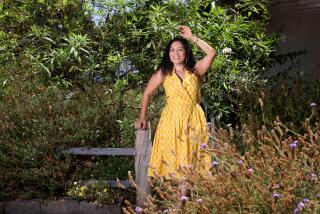Seems Like Old Times
- Share via
Certain plants evoke memories and emotions long forgotten. A whiff of a fragrant rose or the sight of a bold bearded iris can transport the observer back in time to another garden, another place.
Some gardens, like the Heritage Gardens surrounding Heritage House at the Fullerton Arboretum, and the gardens at the McCharles House in Tustin, were specifically created to evoke nostalgia and times long past.
Heritage House was built in 1894 on the original town site of what was to become the city of Fullerton. The modest Eastlake Victorian structure served as home and office for Dr. George Crook Clark, a homeopathic physician. The building was moved onto the arboretum grounds in 1972, and the gardens in front of the house were installed in 1994.
“Rather than creating a historic garden, where only cultivars of that specific era would be used, we’ve endeavored to create a feel and an atmosphere with the plantings to represent what you would have seen at that time,” said Rico Montanegro, assistant director at the arboretum. “Some plants from the Victorian period are included, as well as many modern varieties of old favorites.”
The Heritage Garden is distinguished from the surrounding garden beds by a white picket fence enclosing borders planted densely with shrubs, roses, and mainly perennial plants.
Several antique roses like a noisette that climbs along the house porch, and a shrub version of the dainty polyantha rose, ‘Cecile Brunner,’ are joined by several varieties of David Austin English roses, modern version of Old Garden Roses.
The aptly named pink rose, ‘Heritage,’ is accompanied by a vivid pink variety named ‘Mary Rose,’ a robust red variety named ‘Wenlock’ and the tall, single-flower ‘Shropshire Lass.’
Tall hollyhocks, fragrant lavenders, tall and mid-size varieties of salvias, delicate Queen Anne’s lace, graceful strawflowers, and different types of geraniums are a few of the hundreds of companion plants that brighten and scent this garden.
“We’re using a lot of perennials and are light on annuals to simplify the garden maintenance,” said Glen Williams, the arboretum’s nursery manager who also tends the Heritage Gardens.
“We’re always changing out plants to keep the gardens colorful,” he said. “There’s always something blooming.”
Old photos of the Victorian house show it on a dirt lot. Although there aren’t records of what the landscape looked like at the time the doctor and his family lived there, in all likelihood the garden included herbs for the doctor’s use, vegetables for the kitchen, and probably a cutting garden.
The arboretum plans to create a kitchen garden behind the house by next year.
Although not part of Heritage House, just beyond the perimeter fencing is a historical orchard consisting of fruit tree varieties developed in the Fullerton area at the turn of the century.
The trees are from budstock taken from parent trees that grew within six miles of the arboretum. Visitors can stroll through the avocados and different types of citrus and gaze at the groves that were important crops to Orange County inhabitants a century ago.
Another garden of historic interest, an herb garden, is also adjacent to Heritage House.
Herbs are generally defined as “useful plants” and have been used for centuries to preserve and add flavors to food, for cosmetics, to scent a household and repel moths and other insects, as well as for medicinal uses. All the plants in the arboretum’s herb garden are identified and the labels include information about their traditional uses.
Usefulness of the plants is one criterion for what grows in another period garden in Orange County that can be viewed by the public.
When Audrey Heredia purchased the McCharles House in 1979, she intended to use it as an art studio. Built in 1885 by Columbus Tustin, founder of the city that bears his name, the house had subsequently been used for a nursery school and had fallen into disrepair when Heredia acquired it. Whatever gardens had been originally planted had long since disappeared.
“All that remained were three eucalyptus trees that Tustin had planted sometime in the 1870s,” Heredia said. “The city calls them their heritage trees.”
When Heredia applied for a change of zoning so she could convert the McCharles House to a tearoom, she was required by city officials to install sidewalks, curb and a parking area.
The eucalyptus trees were in jeopardy because sidewalk installation could have damaged their relatively shallow root systems, causing them to become potential hazards. The city thought they should be removed.
Heredia thought otherwise. They reached a compromise by constructing an asphalt sidewalk near the trees that didn’t impact on their roots.
Heredia designed the gardens surrounding the house. She wanted them to reflect the house’s Victorian architecture, provide herbs and garnishments for the restaurant, but even more important was that they recapture youthful memories.
“Everything planted here is important to me and we use the plants that we love,” she said. “Some of the plants are those that were used in the Victorian era, some are plants that I loved when I was a child growing up in Pasadena, and some are cuttings taken from my mother’s garden.”
Heredia noted that she inherited her love of gardens from her late mother, Victoria Swanson Emsel, who died in 1996, and her love of old homes from growing up in Pasadena.
The flower beds surrounding the McCharles House are redolent with fragrance from the many varieties of roses, geraniums, bearded irises, jasmine, a honeysuckle vine and herbs.
“We use the herbs in many of the items we serve and for garnishments, as we do with the rose petals,” she said.
One of the featured menu items is rose petal jam, made from the yellow and red ‘Double Delight’ roses growing on the premises. Although the variety is a modern hybrid tea, the scent is reminiscent of Old Garden Roses.
Heredia enjoys tending the 1,000-square-foot garden and has given up hiring anyone else to take care of it.
“Gardening is my relaxation,” she said. “My customers often laugh because I literally have a green thumb. I’ll often run into the garden to harvest some herbs or to tend to a plant, and because I don’t wear gloves, my thumb is often stained green from plants I’ve handled.”
Frequent Flowers
Some of the plants most often used to create a heritage garden include:
* campanula
* columbine
* daisies
* delphinium
* dianthus
* foxgloves
* geraniums
* herbs
* hollyhocks
* irises
* larkspur
* lavender
* mallows
* roses
* poppies
* salvia
* sweet peas
* violas
* violets






